ESP CITROEN NEMO 2013 Handbook (in English)
[x] Cancel search | Manufacturer: CITROEN, Model Year: 2013, Model line: NEMO, Model: CITROEN NEMO 2013Pages: 180, PDF Size: 9.06 MB
Page 74 of 180

72
Parking sensors
REAR PARKING SENSORS
The audible system consists of four
proximity sensors, fitted in the rear bumper.
It detects any obstacle which comes within
range: person, vehicle, tree, fence, behind
the vehicle during the manoeuvre.
However, it will not be able to detect
obstacles located immediately below the
bumper.
An object, such as a stake, a roadworks
cone or any other similar object may be
detected at the beginning of the manoeuvre
but may no longer be detected when the
vehicle moves close to it.
This system does not take the place of the
vigilance and responsibility of the driver.
Stop the assistance
Change to neutral.
Operating fault
If this warning lamp or the service
warning lamp comes on in the
instrument panel, accompanied
by a message in the screen,
contact a CITROËN dealer or a
qualified workshop.
Good practice
In bad weather or in winter, ensure that the
sensors are not covered with mud, ice or
snow.
Engage reverse gear
The proximity information is indicated by an
audible signal which becomes more frequent
as the vehicle approaches the obstacle.
When the distance between the rear of
the vehicle and the obstacle is less than
approximately thirty centimetres, the audible
signal becomes continuous.
This function will be deactivated
automatically if a trailer is being towed.
You are advised to obtain a towbar
recommended by CITROËN and have it
installed by a professional.
If anomalies are detected on engaging
reverse gear, the warning lamp comes on,
possibly accompanied by a message in the
screen.
72
Page 76 of 180
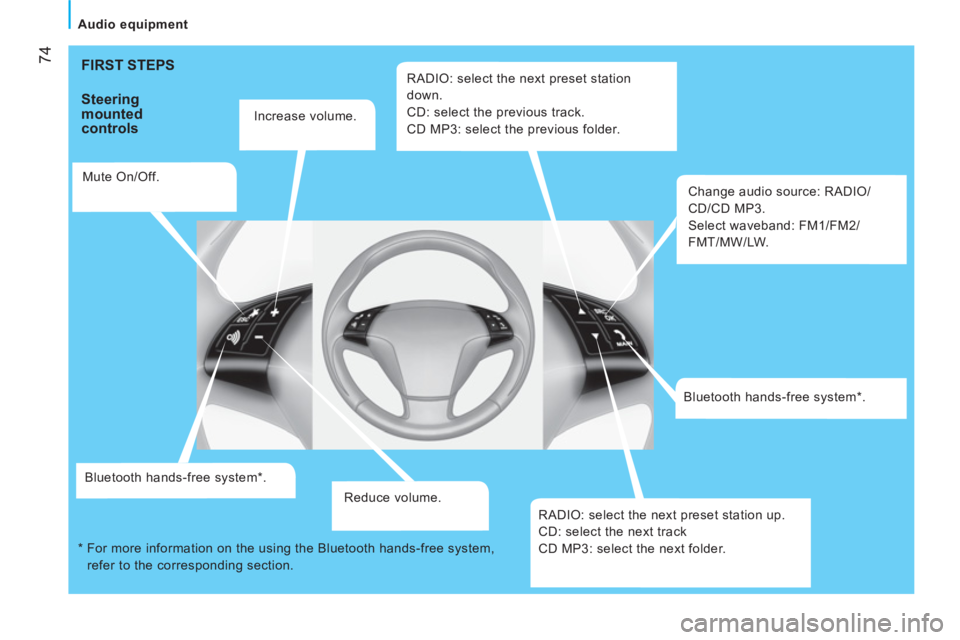
74
Audio equipment
FIRST STEPS
Steering
mounted
controls
Increase volume.
Mute On/Off.
Bluetooth hands-free system * .
Reduce volume.
RADIO: select the next preset station
down.
CD: select the previous track.
CD MP3: select the previous folder.
Change audio source: RADIO/
CD/CD MP3.
Select waveband: FM1/FM2/
FMT/MW/LW.
Bluetooth hands-free system * .
RADIO: select the next preset station up.
CD: select the next track
CD MP3: select the next folder.
*
For more information on the using the Bluetooth hands-free system,
refer to the corresponding section.
Page 83 of 180
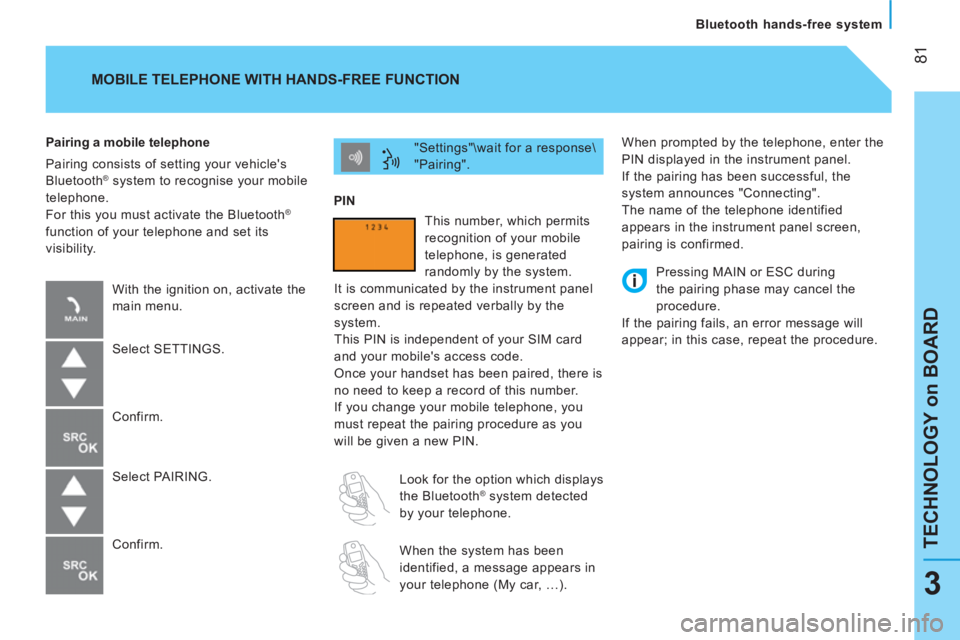
81
TECHNOLOGY on BOARD
Bluetooth hands-free system
3
When prompted by the telephone, enter the
PIN displayed in the instrument panel.
If the pairing has been successful, the
system announces "Connecting".
The name of the telephone identified
appears in the instrument panel screen,
pairing is confirmed. "Settings"\wait for a response\
"Pairing".
PIN
Pairing a mobile telephone
Pairing consists of setting your vehicle's
Bluetooth
® system to recognise your mobile
telephone.
For this you must activate the Bluetooth
®
function of your telephone and set its
visibility.
MOBILE TELEPHONE WITH HANDS-FREE FUNCTION
With the ignition on, activate the
main menu.
Select SETTINGS.
Confirm.
Select PAIRING.
Confirm. This number, which permits
recognition of your mobile
telephone, is generated
randomly by the system.
It is communicated by the instrument panel
screen and is repeated verbally by the
system.
This PIN is independent of your SIM card
and your mobile's access code.
Once your handset has been paired, there is
no need to keep a record of this number.
If you change your mobile telephone, you
must repeat the pairing procedure as you
will be given a new PIN.
Look for the option which displays
the Bluetooth
® system detected
by your telephone.
When the system has been
identified, a message appears in
your telephone (My car, …).
Pressing MAIN or ESC during
the pairing phase may cancel the
procedure.
If the pairing fails, an error message will
appear; in this case, repeat the procedure.
Page 102 of 180

100
Seats
SPLIT REAR BENCH SEAT
The left-hand side (2/3) or right-hand side
(1/3) of this bench seat can be folded to
adapt the load space in the boot.
Table position
Press the head restraint and its lug
simultaneously to place the head restraint in
the low position.
Unlock the seat back by pulling the
corresponding side control towards you. The
red indicator becomes visible.
Fold the corresponding seat back onto the
seat cushion.
Fully folded position
After placing the seat back in the table
position, pull the corresponding strap to
unlock the rear feet of the seat.
Lift the seat fully to secure it in the fully
folded position.
Removing the bench seat
After placing the bench seat in the fully
folded position, lower the corresponding
transverse bar to unlock the front feet of the
seat.
Lift the bench seat to detach it from its front
anchorages.
When driving, to secure the bench,
detach the red retaining strap, located
on the back of the bench seat cushion, and fi x
one end to a front head restraint spindle and
the other end to the side of the seat cushion.
Page 117 of 180
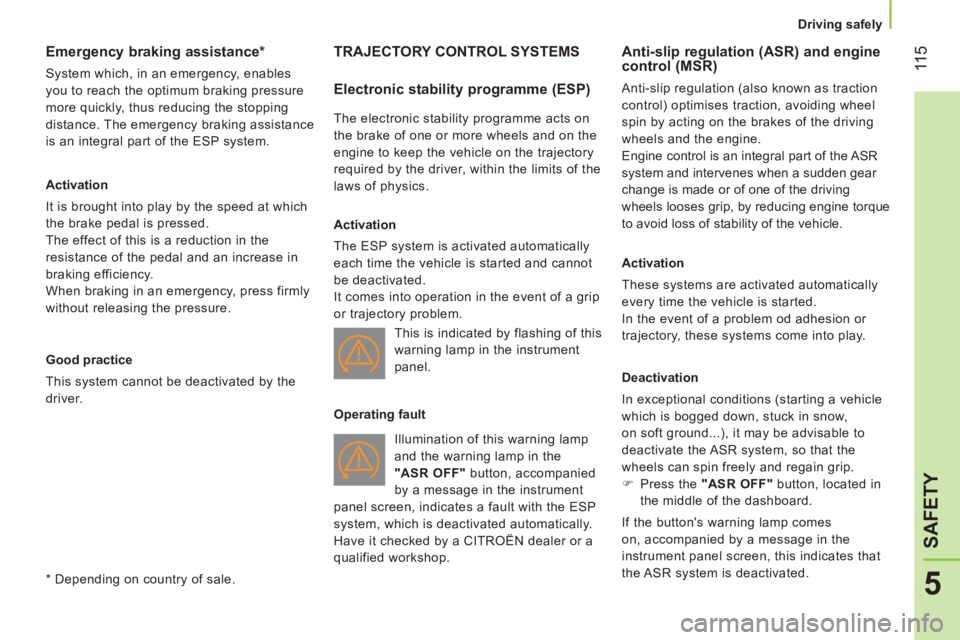
11 5
5
SAFETY
Driving safely
Emergency braking assistance *
System which, in an emergency, enables
you to reach the optimum braking pressure
more quickly, thus reducing the stopping
distance. The emergency braking assistance
is an integral part of the ESP system.
Activation
It is brought into play by the speed at which
the brake pedal is pressed.
The effect of this is a reduction in the
resistance of the pedal and an increase in
braking efficiency.
When braking in an emergency, press firmly
without releasing the pressure.
Good practice
This system cannot be deactivated by the
driver.
*
Depending on country of sale.
TRAJECTORY CONTROL SYSTEMS
Electronic stability programme (ESP)
The electronic stability programme acts on
the brake of one or more wheels and on the
engine to keep the vehicle on the trajectory
required by the driver, within the limits of the
laws of physics.
Activation
The ESP system is activated automatically
each time the vehicle is started and cannot
be deactivated.
It comes into operation in the event of a grip
or trajectory problem.
Illumination of this warning lamp
and the warning lamp in the
"ASR OFF"
button, accompanied
by a message in the instrument
panel screen, indicates a fault with the ESP
system, which is deactivated automatically.
Have it checked by a CITROËN dealer or a
qualified workshop.
Anti-slip regulation (ASR) and engine
control (MSR)
Anti-slip regulation (also known as traction
control) optimises traction, avoiding wheel
spin by acting on the brakes of the driving
wheels and the engine.
Engine control is an integral part of the ASR
system and intervenes when a sudden gear
change is made or of one of the driving
wheels looses grip, by reducing engine torque
to avoid loss of stability of the vehicle.
Activation
These systems are activated automatically
every time the vehicle is started.
In the event of a problem od adhesion or
trajectory, these systems come into play.
Deactivation
In exceptional conditions (starting a vehicle
which is bogged down, stuck in snow,
on soft ground...), it may be advisable to
deactivate the ASR system, so that the
wheels can spin freely and regain grip.
�)
Press the "ASR OFF"
button, located in
the middle of the dashboard.
If the button's warning lamp comes
on, accompanied by a message in the
instrument panel screen, this indicates that
the ASR system is deactivated. This is indicated by flashing of this
warning lamp in the instrument
panel.
Operating fault
Page 123 of 180

121
5
SAFETY
Airbags
LATERAL AIRBAGS
Deployment
It is deployed unilaterally in the event of a
serious side impact, perpendicular to the
longitudinal centreline of the vehicle on
a horizontal plane and directed from the
outside towards the inside of the vehicle.
The lateral airbag inflates between the
front occupant of the vehicle and the
corresponding door trim panel.
In the event of a minor impact or bump
on the side of the vehicle or if the
vehicle rolls over, the airbag may not be
deployed.
Operating fault
If this warning lamp comes on in
the instrument panel, contact a
CITROËN dealer or a qualified
workshop without delay to have
the system checked. The airbags
may no longer be deployed in the
event of a serious impact.
Page 151 of 180
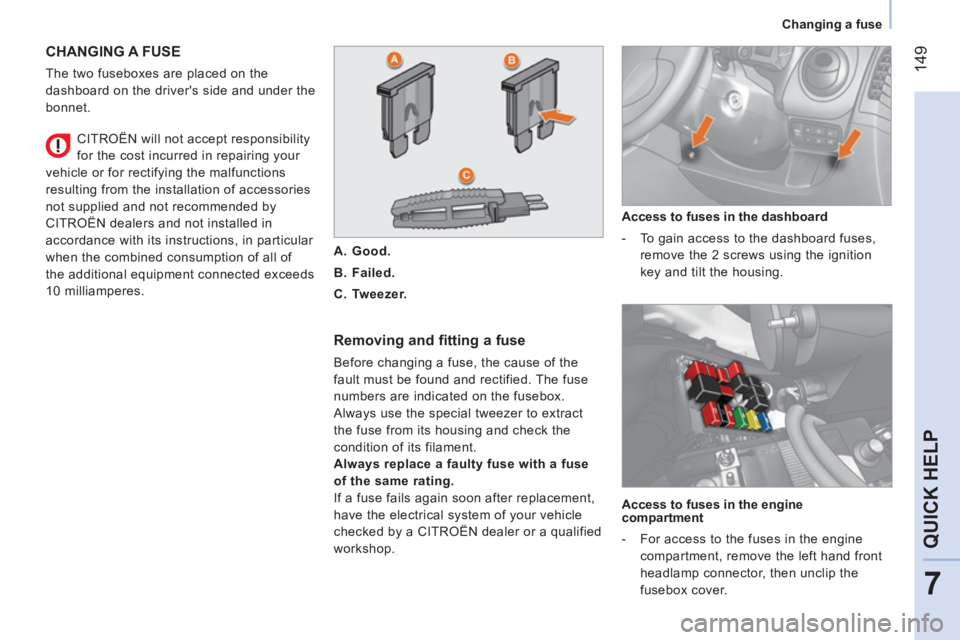
149
7
QUICK HELP
Changing a fuse
CHANGING A FUSE
The two fuseboxes are placed on the
dashboard on the driver's side and under the
bonnet.
Removing and fitting a fuse
Before changing a fuse, the cause of the
fault must be found and rectified. The fuse
numbers are indicated on the fusebox.
Always use the special tweezer to extract
the fuse from its housing and check the
condition of its filament.
Always replace a faulty fuse with a fuse
of the same rating.
If a fuse fails again soon after replacement,
have the electrical system of your vehicle
checked by a CITROËN dealer or a qualified
workshop.
Access to fuses in the dashboard
- To gain access to the dashboard fuses,
remove the 2 screws using the ignition
key and tilt the housing.
CITROËN will not accept responsibility
for the cost incurred in repairing your
vehicle or for rectifying the malfunctions
resulting from the installation of accessories
not supplied and not recommended by
CITROËN dealers and not installed in
accordance with its instructions, in particular
when the combined consumption of all of
the additional equipment connected exceeds
10 milliamperes.
A.
Good.
B.
Failed.
C.
Tweezer.
Access to fuses in the engine
compartment
- For access to the fuses in the engine
compartment, remove the left hand front
headlamp connector, then unclip the
fusebox cover.
Page 167 of 180
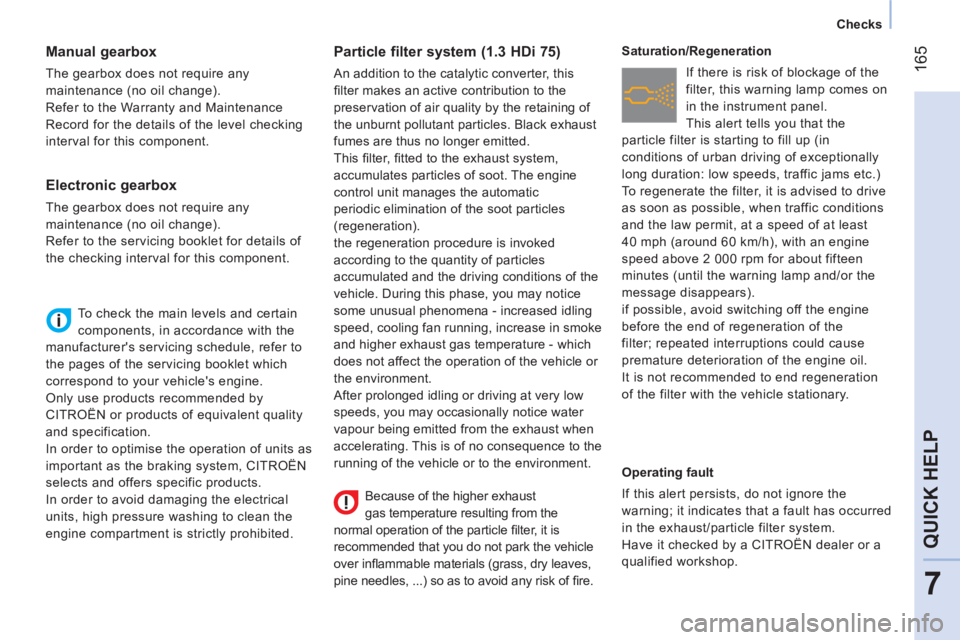
165
7
QUICK HELP
Checks
Manual gearbox
The gearbox does not require any
maintenance (no oil change).
Refer to the Warranty and Maintenance
Record for the details of the level checking
interval for this component.
To check the main levels and certain
components, in accordance with the
manufacturer's servicing schedule, refer to
the pages of the servicing booklet which
correspond to your vehicle's engine.
Only use products recommended by
CITROËN or products of equivalent quality
and specification.
In order to optimise the operation of units as
important as the braking system, CITROËN
selects and offers specific products.
In order to avoid damaging the electrical
units, high pressure washing to clean the
engine compartment is strictly prohibited.
Particle filter system (1.3 HDi 75)
An addition to the catalytic converter, this
fi lter makes an active contribution to the
preservation of air quality by the retaining of
the unburnt pollutant particles. Black exhaust
fumes are thus no longer emitted.
This fi lter, fi tted to the exhaust system,
accumulates particles of soot. The engine
control unit manages the automatic
periodic elimination of the soot particles
(regeneration).
the regeneration procedure is invoked
according to the quantity of particles
accumulated and the driving conditions of the
vehicle. During this phase, you may notice
some unusual phenomena - increased idling
speed, cooling fan running, increase in smoke
and higher exhaust gas temperature - which
does not affect the operation of the vehicle or
the environment.
After prolonged idling or driving at very low
speeds, you may occasionally notice water
vapour being emitted from the exhaust when
accelerating. This is of no consequence to the
running of the vehicle or to the environment.
Saturation/Regeneration
If there is risk of blockage of the
filter, this warning lamp comes on
in the instrument panel.
This alert tells you that the
particle filter is starting to fill up (in
conditions of urban driving of exceptionally
long duration: low speeds, traffic jams etc.)
To regenerate the filter, it is advised to drive
as soon as possible, when traffic conditions
and the law permit, at a speed of at least
40 mph (around 60 km/h), with an engine
speed above 2 000 rpm for about fifteen
minutes (until the warning lamp and/or the
message disappears).
if possible, avoid switching off the engine
before the end of regeneration of the
filter; repeated interruptions could cause
premature deterioration of the engine oil.
It is not recommended to end regeneration
of the filter with the vehicle stationary.
Operating fault
If this alert persists, do not ignore the
warning; it indicates that a fault has occurred
in the exhaust/particle filter system.
Have it checked by a CITROËN dealer or a
qualified workshop.
Electronic gearbox
The gearbox does not require any
maintenance (no oil change).
Refer to the servicing booklet for details of
the checking interval for this component.
Because of the higher exhaust
gas temperature resulting from the
normal operation of the particle fi lter, it is
recommended that you do not park the vehicle
over infl ammable materials (grass, dry leaves,
pine needles, ...) so as to avoid any risk of fi re.